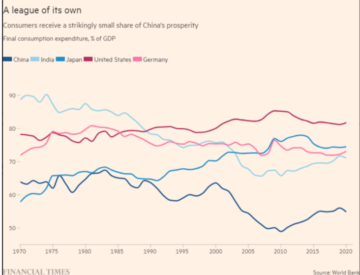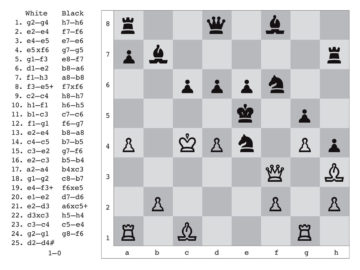 Adam Tooze debates Robert Armstrong and Ethan Wu on whether China can make the adjustments necessary to sustain growth. First, Tooze with a post at the FT’s Unhedged:
Adam Tooze debates Robert Armstrong and Ethan Wu on whether China can make the adjustments necessary to sustain growth. First, Tooze with a post at the FT’s Unhedged:
The common starting point for Chartbook and Unhedged is the view that as far as the world economy and financial markets are concerned China remains the big story.
This is not to say that Russia’s invasion of Ukraine is not a dramatic shock and the risk of escalation is not terrifying. The impact on energy and food prices will be felt worldwide. But China is a whale. A serious crisis and long-term slowdown there will affect every market and practically every economy worldwide. China is also far more deeply financially interconnected with the rest of the world economy than Russia and Ukraine. China’s economic growth is the driver of what it still the primary geopolitical antagonism in the 21st-century world, that between Beijing and Washington.
So the question of China’s growth prospects is a vital one both for policymakers and investors. And this is particularly urgent in light of the signs of serious stress in China’s economy and financial markets.
Armstrong and Wu in Tooze’s Chartbook:
Adam is clear-eyed about China’s challenges, but is optimistic that they can be overcome.
China’s investment-driven, debt-heavy development model needs replacement. Its geopolitical and economic position will become more precarious if the globe’s authoritarian and liberal democratic blocs decouple, a threat made vivid by the war in Ukraine. Its demographics will be a drag on growth. All of this is plain fact. But Adam sees reasons for hope:
- China’s technocrats have, to date, demonstrated competence in managing the economy’s imbalances. “By means of its ‘three red lines’ policy, [China] is stopping in its tracks the most dramatic accumulation of wealth in history … if Beijing manages to stop the largest property boom ever without a systemic financial crisis, it is setting an entirely new standard in economic policy.” Pricking bubbles before they burst and wreak economic havoc is exactly what the US has serially failed to do. “If we look in the mirror, why aren’t we applauding more loudly?” Adam asks.
More here.

 James Meadway in Sidecar:
James Meadway in Sidecar: But as Green says, and his book splendidly demonstrates, “what has disappeared beneath sea can rebuild itself in the mind”. Since the 13th century, when the Suffolk coastline by Dunwich began to be seriously gnawed by the waves, thousands of settlements have disappeared from our maps. It is the untold story of these lost communities – “Britain’s shadow topography” – that has become Green’s obsession. He disinters their rich history and reimagines the lives of those who walked their streets, revealing “tales of human perseverance, obsession, resistance and reconciliation”. By doing so, he makes tangible the tragedy of their loss and the threat we all face from the climate crisis on these storm-tossed islands.
But as Green says, and his book splendidly demonstrates, “what has disappeared beneath sea can rebuild itself in the mind”. Since the 13th century, when the Suffolk coastline by Dunwich began to be seriously gnawed by the waves, thousands of settlements have disappeared from our maps. It is the untold story of these lost communities – “Britain’s shadow topography” – that has become Green’s obsession. He disinters their rich history and reimagines the lives of those who walked their streets, revealing “tales of human perseverance, obsession, resistance and reconciliation”. By doing so, he makes tangible the tragedy of their loss and the threat we all face from the climate crisis on these storm-tossed islands. In 1966, Stewart Brand was an impresario of Bay Area counterculture. As the host of an extravaganza of music and psychedelic simulation called the Trips Festival, he was, according to
In 1966, Stewart Brand was an impresario of Bay Area counterculture. As the host of an extravaganza of music and psychedelic simulation called the Trips Festival, he was, according to  Carl Erik Fisher’s new book, “The Urge: Our History of Addiction,” follows two journeys: One is a memoir of his own addiction to alcohol (he grew up with two alcoholic parents), and the other is a detailed overview of the approaches that have been used to understand, control and treat addiction over time. This last includes the relatively contemporary idea of “recovery,” which suggests that it is possible, with the right medications, such as naloxone, buprenorphine or methadone, and thoughtful care, to break its hold.
Carl Erik Fisher’s new book, “The Urge: Our History of Addiction,” follows two journeys: One is a memoir of his own addiction to alcohol (he grew up with two alcoholic parents), and the other is a detailed overview of the approaches that have been used to understand, control and treat addiction over time. This last includes the relatively contemporary idea of “recovery,” which suggests that it is possible, with the right medications, such as naloxone, buprenorphine or methadone, and thoughtful care, to break its hold. Think about a time when you changed your mind. Maybe you heard about a crime, and rushed to judgment about the guilt or innocence of the accused. Perhaps you wanted your country to go to war, and realise now that maybe that was a bad idea. Or possibly you grew up in a religious or partisan household, and switched allegiances when you got older. Part of maturing is developing intellectual humility. You’ve been wrong before; you could be wrong now.
Think about a time when you changed your mind. Maybe you heard about a crime, and rushed to judgment about the guilt or innocence of the accused. Perhaps you wanted your country to go to war, and realise now that maybe that was a bad idea. Or possibly you grew up in a religious or partisan household, and switched allegiances when you got older. Part of maturing is developing intellectual humility. You’ve been wrong before; you could be wrong now. During a workshop last fall at the Vatican, Stanislas Dehaene, a cognitive neuroscientist with the Collège de France, gave a presentation chronicling his quest to understand what makes humans — for better or worse — so special.
During a workshop last fall at the Vatican, Stanislas Dehaene, a cognitive neuroscientist with the Collège de France, gave a presentation chronicling his quest to understand what makes humans — for better or worse — so special.
 What often gets left out of chronicles about the Banda Islands, of which there are not many to begin with, are the perspectives of Bandanese survivors of the 1621 genocide, and their efforts to remember the past through stories and song. As Ghosh writes, ‘the modern gaze sees only one of the nutmeg’s two hemispheres… [it] is merely an inert object, a planet that contains no intrinsic meaning, and no properties other than those that make it a subject of science and commerce.’ THE NUTMEG’S CURSE shows us the hemisphere cast in a penumbra. Throughout the book, the chiaroscuro effect is extended to certain words as well, like ‘nature’, whose Western conception, Ghosh observes, ‘is the key element that simultaneously enables and conceals the true character of biopolitical warfare.’ The Bandanese have a very different relationship to nature, they view their islands as ‘places of dwelling that were enmeshed with human life in ways that were imaginative as well as material.’ Ghosh quotes the Indigenous thinker Max Liboiron, for whom land is ‘the unique entity that is the combined living spirit of plants, animals, water, humans, histories, and events.’ This is a ‘vitalist’ way of seeing the world that recognises the agency of material things. It’s also a view that any reader of Ghosh’s work implicitly senses. For those new to his writing, THE NUTMEG’S CURSE is not just a ‘parable for planetary crisis’, but also, albeit to a lesser extent, a kind of onboarding manual for his Ibis triple-decker.
What often gets left out of chronicles about the Banda Islands, of which there are not many to begin with, are the perspectives of Bandanese survivors of the 1621 genocide, and their efforts to remember the past through stories and song. As Ghosh writes, ‘the modern gaze sees only one of the nutmeg’s two hemispheres… [it] is merely an inert object, a planet that contains no intrinsic meaning, and no properties other than those that make it a subject of science and commerce.’ THE NUTMEG’S CURSE shows us the hemisphere cast in a penumbra. Throughout the book, the chiaroscuro effect is extended to certain words as well, like ‘nature’, whose Western conception, Ghosh observes, ‘is the key element that simultaneously enables and conceals the true character of biopolitical warfare.’ The Bandanese have a very different relationship to nature, they view their islands as ‘places of dwelling that were enmeshed with human life in ways that were imaginative as well as material.’ Ghosh quotes the Indigenous thinker Max Liboiron, for whom land is ‘the unique entity that is the combined living spirit of plants, animals, water, humans, histories, and events.’ This is a ‘vitalist’ way of seeing the world that recognises the agency of material things. It’s also a view that any reader of Ghosh’s work implicitly senses. For those new to his writing, THE NUTMEG’S CURSE is not just a ‘parable for planetary crisis’, but also, albeit to a lesser extent, a kind of onboarding manual for his Ibis triple-decker. Let me start by asking, Why a perfume? Why not several? A lot of people have perfume wardrobes. You can have a depersonalized relationship to perfume and just ask, How do I want to smell, in a performative way?
Let me start by asking, Why a perfume? Why not several? A lot of people have perfume wardrobes. You can have a depersonalized relationship to perfume and just ask, How do I want to smell, in a performative way? AS PRIVATE SPACE
AS PRIVATE SPACE  All pandemics end eventually. But how, exactly, will we know when the COVID-19 pandemic is really “over”? It turns out the answer to that question may lie more in sociology than epidemiology.
All pandemics end eventually. But how, exactly, will we know when the COVID-19 pandemic is really “over”? It turns out the answer to that question may lie more in sociology than epidemiology. On July 19, 1923, before
On July 19, 1923, before  Stimulated by Levi’s juxtaposition, and motivated by the possibilities of extending an Oulipian sensibility into the sphere of literary criticism (OuCriPo?), the authors set out to develop a means by which a given novel could express itself as a game of chess. Initial success here led to expanded ambition, since there was nothing to stop us from elaborating our modest analytic protocol into a full-fledged “engine” that would permit works of literature to confront one another on the chess board. We have advanced this project to what we think of as a workable tool for a certain sort of ludic literary investigation, and we present it here for the first time, together with some preliminary results drawn from several thousand games we have run to date. The current version of the program is playable on the Cabinet website [see end of article—Eds.], and we would be delighted if it proved useful to those wishing to pursue this or related lines of inquiry.
Stimulated by Levi’s juxtaposition, and motivated by the possibilities of extending an Oulipian sensibility into the sphere of literary criticism (OuCriPo?), the authors set out to develop a means by which a given novel could express itself as a game of chess. Initial success here led to expanded ambition, since there was nothing to stop us from elaborating our modest analytic protocol into a full-fledged “engine” that would permit works of literature to confront one another on the chess board. We have advanced this project to what we think of as a workable tool for a certain sort of ludic literary investigation, and we present it here for the first time, together with some preliminary results drawn from several thousand games we have run to date. The current version of the program is playable on the Cabinet website [see end of article—Eds.], and we would be delighted if it proved useful to those wishing to pursue this or related lines of inquiry.